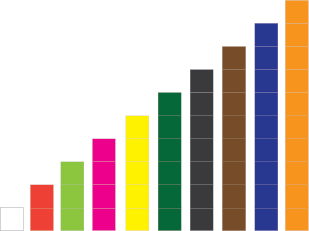Cuisenaire mats
In this unit ākonga use Cuisenaire rods to make 'number mats' that illustrate a variety of numerical patterns and can be visually appealing. Ākonga formally record the number relationships in the mat. This unit is based on the assumption that the small white cube is one. There are many ways Cuisenaire rods can be utilized without naming the white rod as one.
- Use addition and multiplication to find number combinations that 'make' a given result.
It is important for ākonga to know the meaning of the equality sign. Realising that '=' indicates that the two expressions on either side of it are equal, is a key step on the road to algebra. These two expressions have the same status - one does not have to be the 'answer' to the other.
This idea is fundamental to algebraic understanding at later levels. It is introduced here with a geometric technique that links numbers via Cuisenaire rods.
This unit could be repeated at a higher level by assigning a value other than 1 to the white rod.
Links to Numeracy
This unit provides an opportunity to develop the number knowledge of ākonga in the context of Grouping and Place Value. It also provides a way to develop early part-whole thinking in the addition and subtraction domain, as it allows ākonga to clearly see the different ways a number can be partitioned.
To develop ākonga knowledge of groupings within 5 and 10, focus the attention of ākonga on the 5-mat and the 10-mat. For example,
Can you find 2 numbers that join together to make 10 on the 10-mat?
Can you find two different numbers?
How many different combinations can you find?
List the combinations as they are identified. Encourage ākonga to see the relationships between the two addends: as one increases, the other decreases. This is illustrated using the Cuisenaire mats:
This unit can be differentiated by varying the scaffolding provided or altering the difficulty of the tasks to make the learning opportunities accessible to a range of learners. For example:
- simplifying the task by working with smaller numbers, such as 5-mats or 10-mats, and making the task more complex by working with larger number mats such as 12-mats.
- reinforcing the use of materials (Cuisenaire rods) to make all possible number mats so ākonga develop this as sound number knowledge they can rely on
- modelling the use of drawing diagrams to support the thinking of ākonga who are ready to move on from using the structured physical representation of Cuisenaire rods
- supporting ākonga to write numerical representations of the number mats instead of, or as well as, using materials or drawing diagrams.
Refer to the list of ‘possible extensions for Levels 3 and 4’ at the end of the unit for further suggestions of ways in which this unit can be adapted to Levels 3 and 4.
This unit is focussed on making visual representations of number combinations, and as such is not set in a real world context. You may wish to explore real world applications of number combinations in the teaching sessions following the unit, for example ākonga could discuss waka ama with a defined number of seats, with coloured shirts to represent number patterns. For example in a 5-waka, there can be 3 red and 2 blue shirts (3 + 2), 4 red and 1 blue shirts (4 + 1), or 3 red, 1 blue and 1 green shirts (3 + 1 + 1).
Te reo Māori vocabulary terms such as rākau Ātaarangi (Cuisenaire rods) and tau (number), as well as te reo Māori for the colours of the rods and numbers tahi ki tekau (one to ten), could be introduced in this unit and used throughout other mathematical learning.
- Cuisenaire rods for each pair of ākonga.
If they are available, magnetic cuisenaire rods which stick onto a whiteboard are very useful.
Search for “online fractions modelling with cuisenaire rods” to find websites that can be used to make number mats with Cuisenaire rods.
Getting Started
Here the concept of a 5-mat is introduced. It is constructed from combinations of Cuisenaire rods that all have the same length as the yellow rod (5). The 5-mat is a device to help ākonga explore equality of combinations of numbers. It also helps them to see that '=' means 'is equal to'.
- Give each pair of ākonga a set of Cuisenaire rods. Allow time for free play if the rods are new to the ākonga. During the free play, encourage building activities that lead to comparison of the length of the rods and activities that fit them together tightly. A tuakana/teina model could work well here.
- Conduct a class discussion about the lengths of the rods (mahi tahi model). Begin by making a staircase of the rods in increasing length. Then by covering the rods with the unit (white rods), establish the lengths as 1, 2, 3, 4, 5, 6, 7, 8, 9 and 10 times the length of the white rod.
When Cuisenaire rods are exactly made in units of 1 cm, some ākonga may also be able to check the length by measuring.
Draw a clearly labelled diagram on the whiteboard or as a poster, for reference.
- Introduce the idea of a 5-mat. First, ākonga take a 5-rod and put together one other combination of rods that makes 5. For example, ākonga might make 5 as 1 + 3 + 1 (white, green, white), 4 + 1 (pink, white), 2 + 3 (red + green), or as 5 whites. Then these different combinations can be put together as shown in the diagram to make a 5-mat. Of course there are many different 5-mats, but they are all rectangles with the yellow rod (5) as one side.

Ākonga can then suggest the number combinations demonstrated by the 5-mat on the board. The 5-mat above has:
1 + 3 + 1
4 + 1
2 + 3
1 + 1 + 1 + 1 + 1
or 5 x 1= 5
= 5
= 5
= 5
= 5- Note that it is important to keep the numbers in the order that they appear on the mat: 2 + 3 and 3 + 2 would be different rows of the 5-mat. Note also that there are two relationships shown by the row of 5 whites; one is an addition and one a multiplication.
- Next, demonstrate links between the relationships. Explain that the 5-mat also shows other relationships that are true. For example, 1 + 3 + 1 = 4 + 1 and 5 x 1 = 2 + 3 etc. This use of equality may seem strange to some ākonga because it does not give an answer on the right hand side. Explain that '=' means 'is equal to'.
- Ākonga write down relationships from the 5-mat and share some with the class.
- Connect the relationships between the mats and the real world. For example, ‘e rua ika, a toru ika’.Then another could be ‘e wha ika a tahi ika’. Number sentences could be written below. Other examples could be different coloured poi or shirts of people in the waka.
Exploring
Here the concept of 'equal' is explored further using mats of different sizes.
- Ākonga choose a mat to make of a given size. Controlled choice of the size of the mat can allow for individual differences. The diagram below shows four rows of a 12-mat.

- Ask ākonga to record the relationships shown on their mat. The mat in the diagram illustrates many relationships. For instance, 3 + 3 + 3 + 3 = 12 and 4 x 3 = 12.
Note that 4 x 3 is interpreted as 4 groups of 3 here and not 3 groups of 4. - Ākonga should also record some of the relationships between rows on the mat. For example, 6 + 1 + 5 = 3 + 3 + 3 + 3.
- Initiate a class discussion on interesting examples: for example, 5 + 7 = 7 + 5.
Did anyone else find something like this?
Is 4 + 8 = 8 + 4? Why?
Did anyone else find something like this that did NOT work? - Other interesting examples that are worth discussing are things like 4 x 3 = 3 x 4.
Did anyone else find something like this?
Is 2 x 6 = 6 x 2? Why?
Did anyone else find something like this that did NOT work?
Rows that show a strong visual pattern may also show interesting number patterns. - The activity can be repeated using a mat of a different size.
- Turn the situation around.
Make me a mat that shows that 4 + 7 = 2 + 9.
What other equalities can a mat like this show?
Make me a mat that shows that 2 x 5 = 3 + 7.
What other equalities can a mat like this show?
Let ākonga pursue this aspect of the problem in pairs, independently or in small groups. Rove and support ākonga as necessary.
Reflecting
This section brings together what ākonga have discovered so far.
- Ākonga can make a poster or digital presentation (e.g. using Google Slides) of their work on a large piece of paper individually or in a pair. This could involve taking photos of some of the number mats they have made. Some ākonga can report their most interesting findings to the class.
- Highlight the important points. This will include observations about;
- addition (for example, 8 + 1 = 7 + 2 = 6 + 3, 8 + 1 = 1 + 8, and 7 + 2 = 2 + 7)
- multiplication (3 x 4 = 4 x 3)
- and the meaning of equality.
- Is it true that 4 + any number = that same number + 4? Why? Why not?
Is it true that 2 x any number = that same number x 2? Why? Why not?
Possible extensions for Levels 3 and 4
This unit can be extended for ākonga working at Level 3 or Level 4.
- Ākonga can be challenged by changing the value of the white rod from 1 to, say 2, or even 0.1.
- Carefully removing a rod from a number mat leads to a natural setting for equation solving. For example, removing the dark green rod from the mat above, leads to equations such as
? + 1 + 5 = 12; and
? + 1 + 5 = 3 x 4. - A variety of other questions can be asked within the context of the number mats and checked visually. For example, I am making a 16-mat: Can I make a row just out of the light green rods (3-rod)?
Answering this could lead to a statement such as 5 x 3 + 1 = 16.
Use a mat to check whether 2 x 5 + 4 = 6 + 1 + 7 or 5 + 3 x 4 = 7 + 9.
Dear parents and whānau,
This week in maths we have been using coloured Cuisenaire rods to make 'number mats' which help to show that the equal sign '=' says that the numbers on either side of it are the same. Here is an example of a 12-mat. The white rod = 1, the red = 2, the green = 3, the pink = 4 and so on. Each line of colours = 12.

Looking at the green and pink rows, this shows 3 + 3 + 3 + 3 = 4 + 4 + 4. This can be read as 3 + 3 + 3 + 3 is the same as 4 + 4 + 4. Talk with your child about what other equations can be written using the 12-mat.